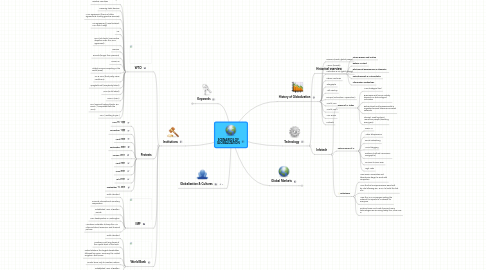
1. Institutions
1.1. WTO
1.1.1. Enhances standards of living in member countries
1.1.2. Lowering trade barriers
1.1.3. WTO agreement (frame of other agreements, trading goods & services)
1.1.4. ITO agreement (1948 finalized, USA didn't ratify)
1.1.5. AD
1.1.6. DSU (rule book, how resolve disputes under the WTO agreement)
1.1.7. Banana
1.1.8. Rounds (longer than previous)
1.1.9. ANCDAD
1.1.10. Global europe competing in the world (2006)
1.1.11. NT & NFN (third party, same conditions)
1.1.12. Spaghetti Ball (everybody lateral)
1.1.13. WTO (multi lateral)
1.1.14. DOHA (2001)
1.1.15. CRT (regional trading blocks, EU, GOLF,..) compatible with the WTO)
1.1.16. SSM ("Getting to yes")
1.2. Protests
1.2.1. June 18, 1999
1.2.2. December, 1999
1.2.3. April 2000
1.2.4. September 2000
1.2.5. January 2001
1.2.6. April 2001
1.2.7. June 2001
1.2.8. July 2001
1.2.9. September 11, 2001
1.3. IMF
1.3.1. Gold Standard
1.3.2. Promote international monetary cooperation
1.3.3. Established 1944 at Bretton Woods
1.3.4. Main headquarters in Washington
1.3.5. Members undertake to keep the IMF informed about economic and financial policies
1.4. World Bank
1.4.1. Gold Standard
1.4.2. Members must buy shares of the capital stock of the bank
1.4.3. United States is the largest shareholder, followed by Japan, Germany, the United Kingdom, and France
1.4.4. Grants loans only to member nations
1.4.5. Established 1944 at Bretton Woods
2. Keywords
2.1. Trade versus Aid
2.2. Accountability
2.3. Brands
2.4. Capitalism
2.5. Communication
2.6. Culture
2.7. Environment
2.8. Equality/Inequality
2.9. Exploitation
2.10. Free Trade?
2.11. Growth
2.12. Integration of Economies
2.13. Monopoly Power
2.14. Outsourcing
2.15. Poverty
2.16. Recognition
2.17. Shrinking World
2.18. Technology/ The Internet
2.19. Terrorism
3. Globalization & Cultures
4. History of Globalization
4.1. Romans (roads, global power)
4.2. Venice (levante)
4.3. Columbus & Co (gold, slavery)
4.4. Steam machines
4.5. Telegraphs
4.6. 19th century
4.7. Europe (colonialism, imperialism)
4.8. World War I
4.9. World War II
4.10. 70's & 80's
4.11. Protests
5. Technology
5.1. Historical overview
5.1.1. Steam Engine and Cotton
5.1.2. Railway & Steel
5.1.3. Electronical Engineering & Chemistry
5.1.4. Petrochemicals & Automobiles
5.1.5. Information Technology
5.2. Infotech
5.2.1. Usage of IT today
5.2.1.1. IT as strategical tool
5.2.1.2. Businesses and human activity depends on technological innovation
5.2.1.3. Entire planet and business world is organized around telecommunicated networks
5.2.1.4. Internet- used by about 100million people (doubling every year)
5.2.2. Future issues of IT
5.2.2.1. Green IT
5.2.2.2. Video telepresence
5.2.2.3. Social networking
5.2.2.4. Micro blogging
5.2.2.5. Distance (Cultural, Economic, Geographic)
5.2.2.6. No Face to Face ever
5.2.2.7. High costs
5.2.3. Milestones
5.2.3.1. 1950 some universities and laboratories begin to work with computers
5.2.3.2. 1970 the first microprocessors were built by Intel allowing IBM & Co. to build the first PCs
5.2.3.3. 1989 the WWW emerges making the network for experts to a network for everyone
5.2.3.4. Dotcom boom and crash financed many technologies we are using today like Voice over IP
6. Global Markets
6.1. USA
6.1.1. Facts
6.1.1.1. GDP growth 2007: 1.8 %
6.1.1.2. GDP growth 1986-2010: 2.7%
6.1.1.3. GDP development 1986-2010: 16.150 bn
6.1.2. The US denominated reserves of the developing world
6.1.3. USA, Mexico, Brazil, Canada: 25% of global electronics output
6.1.4. In 2007: 19% of world electronics production
6.1.5. 1.3 million employees
6.1.6. U.S. electronics industry focused on high-end products (computersµchips)
6.1.7. Silicon Valley (concentration of integrated circuit, software &computer firms)
6.2. Europe
6.2.1. Facts
6.2.2. Global electronics production transfers from Western Europe to Eastern Europe
6.2.3. Germany is Europe largest electronics production nation (183bn $)
6.2.4. ELECTRA 2010
6.2.5. Czech Republic & Hungary most important countries (electronics)
6.2.6. Better infrastructure than in China & India
6.3. Russia
6.3.1. Facts
6.3.1.1. GDP growth 2007: 7.2%
6.3.2. Energy delivery for Europe
6.3.3. Russian investors are investing in european companies
6.3.4. Russia looses quarter of population until 2050
6.4. Africa
6.4.1. Facts
6.4.2. Patents kill
6.4.3. Poverty rate 50% (500 million Africans still subsist on less than $2/day)
6.4.4. 25 million people in Sub Saharan Africa faced a food crisis
6.4.5. In 8 African countries, less than 50% of the population have access to safe water
6.4.6. 8 out of the 10 most vulnerable & weak states are in Sub-Saharan Africa
6.4.7. 1⁄2 of all young people (15-24) can read a simple sentence after 3 years of primary school
6.4.8. 50% - 60% deaths of diseases
6.4.9. World Economic Forum
6.5. Asia
6.5.1. China
6.5.1.1. Facts
6.5.1.1.1. GDP growth 2007: 11.5%
6.5.1.1.2. Population: 1.31 bn
6.5.1.1.3. Capital: Beijing
6.5.1.1.4. Density: 137 inhabitants / km2
6.5.1.1.5. Area: 9.6 m sqm
6.5.1.1.6. GDP growth 1986-2010: 8.1%
6.5.1.1.7. GDP development 1986-2010: 15.367 bn
6.5.1.2. Global GDP sharing four times higher than GER
6.5.1.3. China will displace "Exportweltmeister" GER next year
6.5.1.4. Hub for RaD- activities for international companies
6.5.1.5. Market holds beside big chances risks for international investors
6.5.2. India
6.5.2.1. Facts
6.5.2.1.1. GDP growth 2007: 8%
6.5.2.1.2. Population: 1.12 bn
6.5.2.1.3. Capital: Neu Delhi
6.5.2.1.4. Density: 338 inhabitants / km2
6.5.2.1.5. Area: 3.29 m sqm
6.5.2.1.6. GDP growth 1986-2010: 7.1%
6.5.2.1.7. GDP development 1986-2010: 6398 bn
6.5.2.2. 2050 India will get third largest national economic in the world
6.5.2.3. Quarter of 500 biggest global corporations researches & develops in India
6.5.2.4. Work-intensive industries claims poverty life
6.5.2.5. Market holds beside big chances risks for international investors
6.5.3. Education standard still below the standard – but they catch up quickly
6.5.4. Indias bank- and finance system works better than Chinas
6.5.5. India invests in services while China invests in capital-intensive production processes
6.5.6. Chinas and Indias growing demand for energy is a big challenge for the industrializes countries
6.5.7. RaD-costs in China higher than in India – Scientists more available
6.5.8. China has excess of exports, India is an import-nation and hardly integrated in global trade
6.5.9. Chinas and Indias growing demand for energy is a big challenge for the industrializes countries
6.5.10. Labor costs are not the crucial criteria in investment decisions
6.5.11. Some corporate frameworks are strongly improvable in both countries
6.5.12. USA, Germany and GB are the most important western trade partners for China and India
